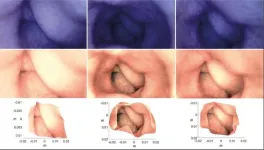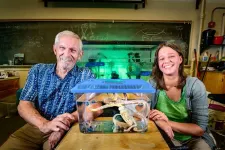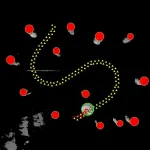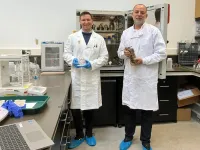(Press-News.org) “Our work shows that it is possible to re-create a fairly accurate three-dimensional (3D) model of the colon of some patients based on a single image taken by a capsule endoscopy camera - even if it's a low-quality image,” says Pål Anders Floor, a researcher at the Department of Computer Science at NTNU.
Goal: better images, faster diagnoses
He has been working for several years on using images from capsule endoscopy cameras to reconstruct an almost identical 3D model of the intestines. These cameras were first used more than 20 years ago, but low-quality images and image noise prevented this smart technology from ever really taking off. The new study, “Single-Image-Based 3D Reconstruction of Endoscopic Images,” was recently published in the Journal of Imaging. This is part of the doctoral research being undertaken by Bilal Ahmad, supervised by Floor and Professor Ivar Farup.
The main aim of this research is to improve the images that specialists use to detect abnormalities in the gastrointestinal tracts of their patients. They can then more easily detect disease and make diagnoses faster. These are important steps on the path to the ultimate goal: fighting bowel cancer, the second most common type of cancer in Norway.
A rubber bowel, an endoscope and mathematics
Using an artificial colon, single images taken by endoscopy and a special algorithm, the NTNU researchers have managed to reconstruct a three-dimensional gut model. The endoscope does the same job as a capsule camera – with some important differences: the images have a higher resolution and the camera brightness can be adjusted manually.
The algorithm that the researchers have used is a called a shape-from-shading algorithm (SFS). This is a mathematical model that can be used to reconstruct a three-dimensional shape from a single, two-dimensional image.
True bowel copy recreated on a PC
If algorithms are fed with images that are noisy, or where the colour is distorted, the errors will spread to the 3D model.
“We show that by carefully calibrating and pre-processing the images, we can obtain a good 3D model based on just one image – even if the image is full of noise and visual distortion,” Floor said.
Great benefits for doctors
Floor and his colleagues have also been working on developing 3D models based on sequences involving several images taken by capsule cameras. This enables the models to re-create longer parts of the colon. The models should make it possible to find out exactly where in the intestines there are abnormalities and signs of disease.
“We have previously shown that doctors find this type of model useful when assessing patients, along with having a video from a capsule camera. Now we have shown that we can calculate relatively accurate 3D models using real images and technology that already exists,” Floor said.
Better, faster, more accurate
In their new work the researchers are reconstructing three-dimensional, relatively high-quality bowel images on the basis of a rather poor original. Their combined efforts are enabling them to reconstruct the geometry of an entire gut.
“The 3D model can be used to adjust the lighting in an original image so that darker areas become better illuminated and more detail can be seen,” Floor said.
“We all have a colon, but the anatomy and geometry of your bowel is probably quite different from your neighbour’s. New 3D models can be adapted to each patient. They allow specialists to examine the digestive tract from different angles on a PC and enable them to plan better and determine exactly where an intervention should take place. Doctors can also practise ahead of particularly difficult procedures, helping reduce the risk of something going wrong,” Floor says.
One step further along the path
The big question is whether or not these new methods could mean a breakthrough in the fight against bowel cancer.
Without the feedback of these doctors, we would largely be fumbling in the dark
“It’s too early to draw any definite conclusions. First, we need to refine what we have developed and do more research. It could take quite a bit of time to achieve results that are statistically valid.”
Top of the cancer statistics
Figures from the Cancer Registry of Norway (in Norwegian) show that Norway tops global statistics in respect of prevalence of and deaths from bowel cancer. It is the second most widespread form of cancer in the country, with 4,912 diagnoses of colorectal cancer in 2023.
Researchers initially had very high expectations about wireless capsule endoscopy (WCE). It was thought the small capsules could replace traditional colonoscopy and gastroscopy, which some people find so painful that they refuse to undergo them.
Camera in a capsule
Capsule cameras, by contrast, can investigate all the nooks and crannies in the intestines, almost imperceptibly and without pain, while the patient goes about their daily life. As soon as it is swallowed, the capsule with the camera commences its laborious journey through the digestive tract. This journey can take many hours, and along the way it transmits tens of thousands of images. As good as it is, this innovation does not work equally well for the whole digestive tract. The capsule camera is the best option for screening the small intestines. As far as the colon is concerned, there is still a way to go before it can replace a colonoscopy.
This is in part because it takes a lot of time to review and analyse such large volumes of data, which means there is a distinct possibility that signs of disease might be missed. The capsule follows the movements of the intestine, progressing in fits and starts. But sometimes the camera suddenly zooms past a polyp without "seeing" it.
Missing important details
It is therefore possible that only one image might be taken of a critical site with signs of disease. Visibility inside the bowel is also very varied, often with little light and all kinds of debris. The images also have poor resolution, and there are no guarantees that what could possibly be the most important image will be sharp and clear.
Herein lies the importance of being able to reconstruct a three-dimensional model based on only one picture, as Floor and his colleagues have now done. The new 3D models will be able to help make gastrointestinal examinations more accurate and less demanding – and ultimately lead to better treatment.
Can be used in many areas
Floor and his colleagues have made several recommendations about how the design of the technology could be improved to obtain even higher quality images. They also believe that the technique could easily be transferred to other areas where it would be helpful to generate three-dimensional shapes and models from images.
The researchers wrote that this could include cultural heritage, robotics, and medical diagnostics, to name but a few.
The effort is part of work package 2 in the Research Council of Norway’s project entitled “Improved Pathology Detection in Wireless Capsule Endoscopy Images through Artificial Intelligence and 3D Reconstruction (CAPSULE).
Floor praises the collaboration with Innlandet Hospital Trust, Gjøvik, and says it has been crucial for the progress of the project. Their specialists have played a crucial role, in both the choice of methodology and evaluating the models along the way.
“Without the feedback of these doctors, we would largely be fumbling in the dark,” he said.
Reference:
Bilal Ahmad, Pål Anders Floor, Ivar Farup, Casper Find Andersen Single-Image-Based 3D Reconstruction of Endoscopic Images Journal of Imaging DOI: https://doi.org/10.3390/jimaging10040082
END
New 3D models of the colon can help detect disease more rapidly
Nobody likes getting a colonoscopy. A new imaging model combined with images from a capsule camera may offer a less invasive alternative.
2024-06-25
ELSE PRESS RELEASES FROM THIS DATE:
Study challenges ED protocols for geriatric head injuries and blood thinners
2024-06-25
Falls are the most common cause of injury among adults 65 and older in the United States. According to the U.S. Centers for Disease Control and Prevention, every year, more than 14 million older adults (one in four) report a fall. About 90% of head injuries among older individuals is due to ground-level falls.
Evaluating an older adult with a head injury in the emergency department (ED) requires careful assessment due to the increased risk of complications such as intracranial hemorrhage. There also is heightened concern for older patients taking anticoagulants or blood thinners who sustain ...
Team aims to improve safety of fertilizers made from wastewater sludge
2024-06-25
Fertilizers manufactured from the sludgy leftovers of wastewater treatment processes can contain traces of potentially hazardous organic chemicals, according to a new study by Johns Hopkins University researchers.
The research, published today in Environmental Science & Technology journal, provides one of the most comprehensive looks at the chemical composition of so-called biosolids across the country and is the first step toward identifying common chemical contaminants that may need government regulation. The findings could ...
From 'CyberSlug' to 'CyberOctopus': New AI explores, remembers, seeks novelty, overcomes obstacles
2024-06-25
CHAMPAIGN, Ill. — By giving artificial intelligence simple associative learning rules based on the brain circuits that allow a sea slug to forage — and augmenting it with better episodic memory, like that of an octopus — scientists have built an AI that can navigate new environments, seek rewards, map landmarks and overcome obstacles.
Reported in the journal Neurocomputing, the new approach gives AI the ability to explore and gather the information it needs to expand its spatial and temporal awareness, growing its knowledge base while learning on the job, said Ekaterina Gribkova, a postdoctoral researcher at the University of Illinois Urbana-Champaign who ...
The evolution of firefly lights
2024-06-25
The leading hypothesis for the origin of firefly lights has been overturned by a genomic analysis. It had been posited that the bright lights emitted by many species in the Lampyridae family of beetles—better known as fireflies—first evolved as a warning signal to predators, advertising the toxicity of fireflies, and were then repurposed as a mating signal. This explanation would account for why eggs, larvae, and pupae also glow. Ying Zhen and colleagues put the conventional wisdom to the test by compiling a family tree of fireflies and tracing the evolution of the chemical compounds ...
ASAP launches data-sharing tool with unique dataset of human postmortem-derived brain samples
2024-06-25
ASAP Launches Data-Sharing Tool with Unique Dataset of Human Postmortem-Derived Brain Samples
Aligning Science Across Parkinson’s (ASAP) launched a platform to make high-value data for Parkinson’s disease broadly available to researchers all over the world
The platform launches with data from a unique human postmortem-derived brain sequencing collection, including samples from four ASAP Collaborative Research Network (CRN) teams and 156 donors
The database will continue to expand, with 629 donors contributing to the final harmonized dataset; there will be a consistent cadence of new ...
Moving objects precisely with sound
2024-06-25
In 2018, Arthur Ashkin won the Nobel Prize in Physics for inventing optical tweezers: laser beams that can be used to manipulate microscopic particles. While useful for many biological applications, optical tweezers require extremely controlled, static conditions to work properly.
“Optical tweezers work by creating a light ‘hotspot’ to trap particles, like a ball falling into a hole. But if there are other objects in the vicinity, this hole is difficult to create and move around,” says Romain Fleury, head of the Laboratory of Wave Engineering in EPFL’s School ...
Sustainable electrification: Managing resource demands for future electric vehicles
2024-06-25
With goals to limit CO2 emissions, many countries have set targets to phase out internal combustion vehicles in favor of electric vehicles (EVs). Japan has set a target for 20-30% of all car sales to be battery electric vehicles (BEVs) and plug-in hybrid electric vehicles (PHEVs), and 30-40% of car sales to be hybrid electric vehicles (HEVs) by 2030. The USA plans for 50% of new vehicles to be zero-emission by 2030, while Germany wants to have 15 million EVs on the road by 2030. These goals raise concerns about the raw material demand for EVs. Batteries, which account for 50% of all resources consumed in BEV production, require ...
New AI program from BU researchers could predict likelihood of Alzheimer’s disease
2024-06-25
Trying to figure out whether someone has Alzheimer’s disease usually involves a battery of assessments—interviews, brain imaging, blood and cerebrospinal fluid tests. But, by then, it’s probably already too late: memories have started slipping away, long established personality traits have begun subtly shifting. If caught early, new pioneering treatments can slow the disease’s remorseless progression, but there’s no surefire way to predict who will develop the dementia associated with Alzheimer’s.
Now, Boston University researchers say they have designed a promising new artificial ...
Telltale greenhouse gases could signal alien activity
2024-06-25
If aliens modified a planet in their solar system to make it warmer, we’d be able to tell. A new UC Riverside study identifies the artificial greenhouse gases that would be giveaways of a terraformed planet.
A terraformed planet has been artificially made hospitable for life. The gases described in the study would be detectable even at relatively low concentrations in the atmospheres of planets outside our solar system using existing technology. This could include the James Webb Space Telescope, or a future European-led space telescope concept.
And ...
New study unveils formation secrets of tiny rare earth elements
2024-06-25
Researchers from Trinity College Dublin’s School of Natural Sciences have revealed a novel route to the formation of bastnäsite, a crucial mineral for the extraction of rare earth elements (REEs). Their work offers promise in one day making the extraction of these REEs more efficient.
The study – published today in the journal Nanoscale – uncovers for first time how fluocerite, a rare mineral, quickly forms and transforms into bastnäsite. The occurrence and origin of fluocerite in natural deposits was not fully understood, ...
LAST 30 PRESS RELEASES:
Tracing the quick synthesis of an industrially important catalyst
New software sheds light on cancer’s hidden genetic networks
UT Health San Antonio awarded $3 million in CPRIT grants to bolster cancer research and prevention efforts in South Texas
Third symposium spotlights global challenge of new contaminants in China’s fight against pollution
From straw to soil harmony: International team reveals how biochar supercharges carbon-smart farming
Myeloma: How AI is redrawing the map of cancer care
Manhattan E. Charurat, Ph.D., MHS invested as the Homer and Martha Gudelsky Distinguished Professor in Medicine at the University of Maryland School of Medicine
Insilico Medicine’s Pharma.AI Q4 Winter Launch Recap: Revolutionizing drug discovery with cutting-edge AI innovations, accelerating the path to pharmaceutical superintelligence
Nanoplastics have diet-dependent impacts on digestive system health
Brain neuron death occurs throughout life and increases with age, a natural human protein drug may halt neuron death in Alzheimer’s disease
SPIE and CLP announce the recipients of the 2025 Advanced Photonics Young Innovator Award
Lessons from the Caldor Fire’s Christmas Valley ‘Miracle’
Ant societies rose by trading individual protection for collective power
Research reveals how ancient viral DNA shapes early embryonic development
A molecular gatekeeper that controls protein synthesis
New ‘cloaking device’ concept to shield sensitive tech from magnetic fields
Researchers show impact of mountain building and climate change on alpine biodiversity
Study models the transition from Neanderthals to modern humans in Europe
University of Phoenix College of Doctoral Studies releases white paper on AI-driven skilling to reduce burnout and restore worker autonomy
AIs fail at the game of visual “telephone”
The levers for a sustainable food system
Potential changes in US homelessness by ending federal support for housing first programs
Vulnerability of large language models to prompt injection when providing medical advice
Researchers develop new system for high-energy-density, long-life, multi-electron transfer bromine-based flow batteries
Ending federal support for housing first programs could increase U.S. homelessness by 5% in one year, new JAMA study finds
New research uncovers molecular ‘safety switch’ shielding cancers from immune attack
Bacteria resisting viral infection can still sink carbon to ocean floor
Younger biological age may increase depression risk in older women during COVID-19
Bharat Innovates 2026 National Basecamp Showcases India’s Most Promising Deep-Tech Ventures
Here’s what determines whether your income level rises or falls
[Press-News.org] New 3D models of the colon can help detect disease more rapidlyNobody likes getting a colonoscopy. A new imaging model combined with images from a capsule camera may offer a less invasive alternative.







